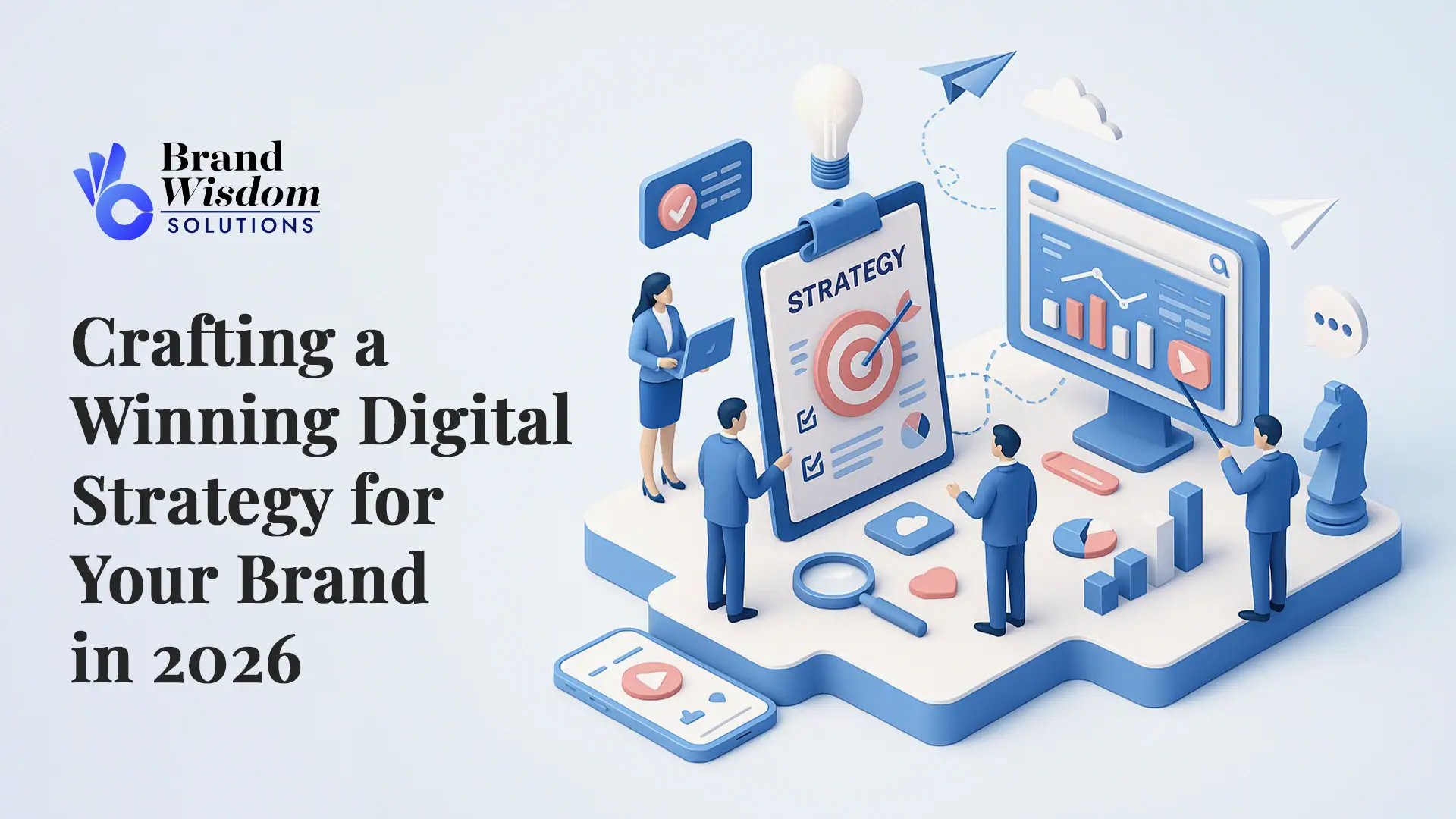In the quick-paced age of digital technology, a solid online presence is not a nicety anymore—but a necessity. Companies that do not evolve and reinvent their business model, such as Blockbuster and BlackBerry, soon become footnotes in history. You don’t have to suffer the same fate if you have a vision-oriented digital strategy. This strategy serves as your compass amidst the maze of digitalization, helping your brand not just survive but flourish. Are you ready to create a strategy that ensures the future of your brand?
Understanding Digital Strategy for 2026

So, what is a digital strategy? Essentially, it’s a comprehensive plan that documents how your organization will use digital technology to achieve its key goals. In today’s world of rapid technological change, a well-thought-through strategy assists you in riding the tide of change and capturing new opportunities for development.
Without a specific plan, it’s simple to fall behind. A defined digital strategy keeps your efforts targeted and your technology investments yielding real returns. Let’s examine what this means for your brand and why its significance keeps increasing.
Defining Digital Strategy for Modern Brands
A digital strategy is the plan that bridges your business strategy with the digital space. It’s not necessarily having a website or a social page; it’s the complete strategy for leveraging technology to be more competitive and more efficient. That means a thorough analysis of your business model and processes to identify where digitalization can impact.
For any modern digital business, this plan is vital. It provides direction for your digital transformation journey, ensuring that every technological investment supports your broader goals. Whether you’re looking to improve operations or innovate your offerings, your digital strategy is the key.
In the end, it’s all about developing a sustainable way forward. It informs you of how to leverage digital tools to not just reach your market but also to automate operations, disrupt your products, and create a robust brand for the future.
The Evolving Importance of Digital Strategy in Today’s Business Landscape
The business world is continuously changing, mainly because of fast-paced technological changes. In this fluid digital economy, a rigid approach simply will not do. A dynamic digital strategy is essential to remain in touch and stay ahead. It enables your brand to respond to the changes in the market and embrace new business models.
Consider firms that have been able to ride this wave. They didn’t merely implement new tools; they incorporated them into their fundamental operations, driving a complete digital revolution. Being at the forefront of this push enables them to be proactive in meeting customer needs and staying ahead of others who lag behind.
Having a successful strategy entails being nimble. It involves continuously tracking trends, evaluating performance, and being open to innovating. Through these, you can convert change into opportunity and gain a commanding position in your field.
Building Blocks of an Effective Digital Strategy

Developing a successful digital plan is more than having a general notion of what you need to do. It takes a systematic process based on several fundamentals. From defining your objectives to knowing your data strategy, each building block is crucial for creating a plan that brings return on investment.
These building blocks lead your digital marketing initiatives and enable you to streamline your business processes for the digital era. Here are the first two fundamental building blocks: defining clear goals and segmenting your target market.
Setting Clear Goals and Objectives
The first thing to do in outlining any winning digital strategy is to articulate what you aim to do. Your objectives are the drive behind your whole plan, and therefore, they must be specific and unambiguous. General wishes such as “boost sales” won’t do. Instead, set your business goals with exactness, for example, “boost online sales by 15% by the close of the fourth quarter.”
This degree of specificity assists in measuring progress in concrete terms and gets your team on the same page. Your online objectives should be aligned with your broader business strategy and support your greater digital transformation initiatives.
Following are some typical goals firms often aim for:
- Enhance customer service and rates of customer satisfaction
- Sustain costs savings through automation
- Create brand awareness among new market segments
By establishing these specific goals, you have a guide that directs your choices and makes your actions meaningful.
Identifying and Analyzing Your Target Audience
Who are you attempting to reach? Responding to this question is the cornerstone of your digital strategy, be it a large corporation or nonprofit organization. You must create a clear, descriptive picture of your ideal customer, what they need, what concerns them, and how they behave online. By gaining this understanding, you can frame your messaging and develop an improved customer experience.
Assets such as Google Analytics and insights are priceless in this regard. They give information on who is visiting your online media platforms, what they use your content for, and how they discover you. These are useful pieces of information that enable you to tweak your approach to serve your audience better.
Understanding your audience informs you on everything from content development to channel choice. Here’s a straightforward method of parsing your audience analysis:
| Analysis Area | Key Questions to Answer | Data Sources |
| Demographics | What is their age, location, and gender? | Google Analytics, Social Media Insights |
| Needs & Pain Points | What problems are they trying to solve? | Customer surveys, support tickets, reviews |
| Online Behavior | Which social media platforms do they use? What content do they prefer? | Social media analytics, website heatmaps |
Principles and Best Practices for Success

It’s easy to develop a great digital strategy, but it is another to implement it. Success is contingent on sticking to some key principles and best practices that keep your efforts on target. These rules help your plan stay flexible, effective, and consistent with your long-term vision.
A nimble digital transformation approach enables you to keep up with the constantly evolving digital world. One of the key principles is selecting the appropriate channels for delivery of your message, which we will discuss below.
Selecting the Proper Digital Channels
All digital channels are not equal, and selecting the right ones is critical to ensure your strategy connects with your business objectives. You should select channels based on both your goals as well as your audience. Where does your dream customer spend their time online? Knowing this helps you concentrate your resources where it will make the biggest difference.
For example, if your main objective is to create brand awareness, visual platforms such as Instagram or having a strong web presence may be your best option. Yet, if you wish to develop leads you already have, an email campaign or proprietary content within a mobile app would prove better digital services.
Content Strategy’s Role in Brand Success

At the center of every successful digital strategy is a strong content strategy. Content is the message by which you’re talking to your audience, establishing customer relationships, and defining your brand’s authority. Without quality content, even the best laid strategy will fail.
Your content—your blog posts and videos, as well as your social media posts—is what gives your online presence substance. It is the basis for brand success in today’s digital world. Let’s explore creating engaging content and keeping it relevant to your goals.
Creating Engaging, High-Quality Content
Quality content is the backbone of your online marketing strategy. But what constitutes “quality content?” It must be thoroughly researched, informative, and compelling to your target market. Whether your aim is to educate or entertain, your content has to deliver genuine value to the consumer.
In order to do this, always make sure you do your research on your topic in depth. Have all of the digital media that you create reviewed and edit it for mistakes to prevent them from breaking up your message. New technologies such as artificial intelligence and machine learning can assist with you examining what subjects interest your target audience the most.
Some of the following forms of content can be used for your plan:
- Informative articles and blog posts
- Engaging videos and tutorials
- Interactive social media posts and polls
In the end, excellent content earns trust and has your viewers coming back for more.
Aligning Content with Business Objectives
Your content strategy can never sit in a vacuum. To be effective, it needs to be closely coupled with your bigger business strategy and goals. Each bit of content you produce ought to have some purpose that maps back to a desired goal, whether it’s lead generation, customer experience improvement, or driving sales.
For instance, if one of your primary business goals is to make your brand a thought leader in your industry, your content strategy would center around developing insightful, data-driven blog posts and whitepapers. If you want to improve customer retention, you could develop a sequence of how-to videos and support articles.
This alignment is a key component of your digital transformation. It makes sure that your content is not noise but a strategic asset that takes your business forward. When you link your content to your objectives, you can measure its performance and show a clear return on investment.
Conclusion
In conclusion, developing a successful digital strategy for your brand in 2026 is not merely a matter of staying trendy; it’s a matter of recognizing the changing landscape and positioning your goals to meet the requirements of your audience. Through setting clear goals, using the proper digital channels, and producing compelling content, you can set your brand up for success in this competitive landscape. Don’t forget, your digital strategy is a living document that will need to change as you evolve. If you’re ready to take your digital strategy to the next level, don’t wait to get in touch for a consultation!
Frequently Asked Questions
How is digital strategy different from digital transformation?
A digital strategy is the strategy or blueprint describing how you will utilize digital technology to help you meet your objectives. Digital transformation is actually executing the strategy, which means that you are radically altering your business model and business processes throughout the organization to incorporate technology into all aspects.
What are some of the challenges associated with applying digital strategies?
Companies frequently encounter obstacles such as dismantling data silos, employee resistance to change, and filling the internal skills gap. In order for a successful digital transformation and to take advantage of new possibilities to enhance the customer experience and align with business objectives, these obstacles need to be overcome.
Is there an example of a successful digital strategy in a large company?
Nike is a fine example of a successful digital strategy. As part of its strategy, Nike invested greatly in digital media, such as its mobile app and social media. These applications helped make the customer experience seamless, increase online sales, and solidify its brand through digital transformation.





